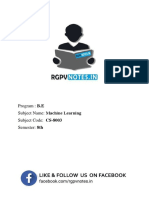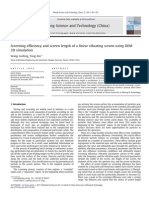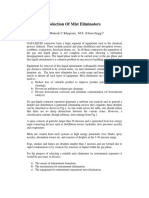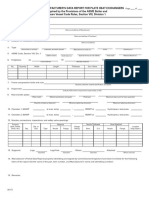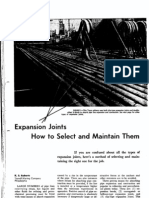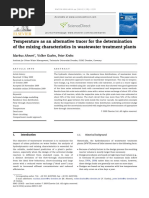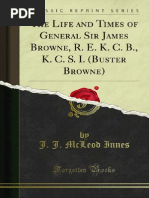Screens and Screening
Screens and Screening
Uploaded by
CalcetinCopyright:
Available Formats
Screens and Screening
Screens and Screening
Uploaded by
CalcetinOriginal Description:
Copyright
Available Formats
Share this document
Did you find this document useful?
Is this content inappropriate?
Copyright:
Available Formats
Screens and Screening
Screens and Screening
Uploaded by
CalcetinCopyright:
Available Formats
ENGINEERING FEATURES liqu :
as d
with
Screens and screening clea]
Wir
Se
moro
Wire cloth is used for sieves, strainers and filters. since
cloth
Here are some tips on how to select it wisely. For <
caust
good
John Muldoon, Newark Wire Cloth Co. ment
Hasta
Wi
❑ Wire cloth is an interweaving of wires of a particular the effectiveness of a production grinder or an industrial espec
diameter to form a screen having openings of a definite screening unit, or check the state of a fluidized catalyst. a ttacl,
size. Its most common function is to separate desirable Sieves are precision tools, available in a range of the fli
material from undesirable. Wire cloth can also perform a standard sizes, that can be combined to provide multi- other
separation or sizing function when there is no undesir- ple-screen analyses simultaneously. The series of stan- surfac
able component in the process. dard testing sieves is based on the ratio of (2) 1/4 . The corro.
In a typical process plant, screens will be found per- openings of the sieves are sized in an exact progressive might
forming some, or all, of the following: ratio, so that each larger sieve has openings 1.189 times corro:
■ Size classification (also laboratory testing), or check- (linear dimensions) those of the one before it. Ref. 2 warnii
ing production quality. summarizes the U.S. specification for test sieves. Ref. 1 the fi]
■ Separating dry product by size, or breaking up also explains the differences between the U.S. Standard corros
lumps and reducing product to a uniform size. and the recommended International Standard. In d
■ Separating solids from fluids in process filtration. The sieves are usually made of stainless-steel cloth and given
■ Removing impurities from untreated water intakes, mounted in a stainless-steel frame because such steels ture, v
or pollutants from plant effluents. have the widest range of application in terms of corro- the pai
sion and abrasion resistances, and material strength. Flowra
Test sieves Depending on their projected use, sieves may also be ties cal
Test sieves are used to obtain information about the made of brass or phosphor-bronze wire cloth, and
size ranges of dry materials in a sample. Test sieving is a mounted in brass frames.
quick, reliable method of size analysis. All that is re-
quired is a set of standard sieves—the shaking can be Production screens
10 3
done by hand. But where much testing will be done, a In chemical-process-industries plants, screens can sep-
shaking machine [1] can save time and energy. arate dry materials by size in equipment using vibratory
Most specifications for solid raw materials and fin- or gyratory motion—for example pigments or pharma-
ished products stipulate the range of sizes for the materi- ceuticals must usually be of uniform size. Screens are
al, or the maximum or minimum size, in terms of the U.S. also used for deagglomeration, i.e., to break up lumps in
Standard Testing Sieve series (developed by the U.S. raw materials or finished products.
Bureau of Standards). For example, test sieves are used Test sieves are very precise, but typical production 10 2
in laboratory testing and quality control of particle size screens sacrifice accuracy for long life.
and uniformity for crystals, powders, pigments and pow- Wire cloth for production screens is available in a
dered metals. Often, laboratory tests are used to check variety of sizes to separate particulate matter ranging
from several inches to a few micrometers—and in some
cases to less than a micrometer. (One micrometer equals
0.001 mm, or 0.00003934 in.) Exactly what do these
Average sizes of common materials Table I 10
particle sizes mean? Table I lists some examples of
materials in the various size ranges.
Size range, Size range,
Typical material in. mm Process filtration
Gravel, ore 3 - 0.1 75 - 2.8 Wire cloth is used to separate solids from liquids, as in
Coarse sand 0.09 - 0.03 2.4 - 0.7 Flowrates an
dewatering. It may also be used to separate solids from a pressure di
Medium sand 0.02 - 0.01 0.6 - 0.3
gases, as in scrubbers. For such services, the wire cloth is of 2 r
Fine sand 0.009 - 0.004 0.25 - 0.1
Silt, powder 0.003 down 0.09 - 0.005 normally incorporated into strainers and filters. 0.1
Fine powder, talc 0.001 (1 ,um) In general, strainers remove solid materials by use of a
coarser mesh having larger openings than do filters.
Adapted from Karassik, Igor J., others, eds. "Pump Hand-
Filter cloth is sometimes used alone as a fine strainer, but
book", McGraw-Hill, New York, 1976. typically it acts as a support structure for filter aids. Wire-clot
Common examples are pressure or vacuum filters where for varios
90 CHEMICAL ENGINEERING FEBRUARY 6, 1984
liquid-solid mixtures are forced through a filter aid such shown in Fig. 1. Such a nomograph will help to find the
as diatomaceous earth or perlite. Microscopic channels required area of the filter or strainer needed to pass a
within the filter aid entrap suspended particles but allow specific flowrate at a given pressure drop.
clear liquid to pass through.
Strainer configurations
Wire cloth for filters and strainers Strainers are primarily designed to handle a specific
Selecting a wire cloth for a filter or strainer is often a flowrate or to achieve a desired filtration within a reason-
more demanding task than for screening dry materials able space. The most common design for strainers is a
since fluids tend to cause more-intensive corrosion. Wire variation of the cone. This simple configuration offers
cloth is available in a variety of materials of construction. optimum strength and surface area.
For example, nickel cloth is usually chosen for filtering Cone strainers range in size from less than 1/4 in. dia.
caustic solutions; stainless steels and Monels provide lo more than several feet. For increased strength and
good performance in many other chemical environ- flow area, the strainers may be fluted or corrugated,
ments. Sometimes, wire cloths are made from titanium, multilayered or multitiered; or filtration may take place
Hastelloys, and even noble metals. through several stages by using wire cloth ranging from
Wire cloth is particularly vulnerable to corrosion, coarse to fine.
especially when immersed in a corrosive fluid. Instead of Fig. 2 shows some typical conical pipeline strainers.
attacking only one surface of a metal plate (as in a vessel), Perforated metal is the strongest; wire cloth provides the
the fluid can attack the entire outer surface of the wire (in finest filtration; perforated metal backing up a wire cloth
other words, for a given weight of metal, there is a larger attempts to use the best qualities of each material.
surface area in a wire screen than in a flat plate). Hence, a
corrosion rate that would be negligible for a metal plate Screens for water treatment
might be excessive for wire cloth. On the other hand, A major use of wire cloth in the process plant is for
corrosion of wire-cloth components can serve as an early water treatment. This may involve cleaning raw water
warning. If a change in the process causes corrosion of before intake or clarifying effiuent before discharge. In
the filter, chances are that similar but less-noticeable such services, wire-cloth strainers are used to keep solid
corrosion is occurring throughout the process system. contaminants out of the system, or to keep solid pollut-
In dealing with fluid filtration, consideration must be ants in the system until they are removed for disposal.
given to pressure-drop requirements, liquid tempera- Water treatment involves strainers similar to those for
ture, viscosity, and specific gravity, as well as the size of process filtration, but on a larger scale and with coarser
the particulate matter to be removed or passed through. removal requirements. For example, intake trash
Flowrates through wire cloth for fluids of varying viscosi- screens, strainers and traveling screens protect process
ties can be determined from a nomograph, such as that equipment by removing solid contaminants from plant
10 3
k■Lnum:azzaw■ wwmalle.
MOI~IIIMICINII~IIIIIIIIMMIL <,,,
.~..~
Mi"■■ ••11011111111MWMOZEh'
RCIIIIIMICIIIIIMMIIMMIMMlí4
111,9011M111 ■1
WILIENNINIZE 11111111111t
b■ambanim ■lo ■zumplw
111511111111'-¿
•■
O►MIMILIEW ►I■, 1111W11
102 ~omemmemommowao".~1~~
.■■••■~NIMMEMZE~~11~111"
...~~...
••■■INN"
WIII■ 1~11~18111 ■■■■■ ■•
Mg", MZEIMIR,M ■k4k
IMMEMWMINZU"Ilia. ■ ILUU11111M~11~
MiNIMIIMIIIMM
WWW01 ■111111",
,
■ 11~11111~1111111=
■
11111■111111CIEINEIIIIIII M■ I
11111 101311011»". •UNIIIIMI 11111111
■ amiskl I ambislimati Cross sections
10 1.--EIL...0.1.....
ammaimi.....
MIEN 1RE
B ■ REIS.....31 ".....1•111~1"111M1MMIIIIME
~IMMIZIWIRMIIIMIN"WEIMW~W~1111•11= 1•1
minammammumonwomalicameoznawanmamt
111~111=111•~10111111~111 ■ 111100 ■11111111•IMI
mmilimmillaugaminfilgammaina
1111111 ■ 111~1111011111111111 sol Perforated metal
Flowrates
l are based on 11211111111E11111111
a pressure differential wunliatuala
1 1
4°95f
! of 2 ps i 11 ■latr
..17'.41
1 I I
0.1 0.5 1.0 5 10 50 100
F lowrate, gpm/in 2 Wire cloth inside, Wire cloth outside,
perforated outside perforated inside
Wire-cloth flowrates Cross sections of varieties of conical strainers Fig. 2
for various-sized screens Fig. 1
CHEMICAL ENGINEERING FEBRUARY 6, 1984 91
SCREENS AND SCREENING
n Space Wire-cloth features
Warp Wire cloth is woven from metallic wires on special
(lengthwise) looms. The wires may be drawn from any malleable
wires materials to virtually any diameter—ranging from an
inch, or more, down to thousandths of an inch.
The term mesh (see Fig. 3) refers to the number of
_--Shute
openings per lineal inch; whereas space refers to the
(crosswise) distance between facing edges of two parallel wires.
wires Wires that run lengthwise with the cloth are called the
warp wires (the same as in weaving cloth), and the back-
and-forth (crosswise) wires are the fill or shute wires.
Wire cloth is manufactured in standard lengths of 100
ft, and widths of 36 or 48 in. Suppliers will cut the
standard bolts to any length or size. Most suppliers also
fabricate the cloth into strainers, filters and other parts,
Mesh: 5 mesh/in. or components as specified; and they will often replace
wire cloth on existing equipment.
Some wire-cloth terminology Fig. 3 Open area of wire cloths
Where flow or throughput is important, it is necessary
to know the open area of the cloth being considered.
intake water (perhaps preceded by a log rake, made of This area will depend on the number of mesh openings
heavy metal bars, to remove the largest objects). per inch, and the diameter of the wire. The simplest way
When a plant or process stream is started up, a strainer to calculate the open area for a given cloth is to deter-
is usually incorporated into the process pipeline to re- mine the projected area for all the wire used in a square
move scale and construction debris. This will protect the inch, and then subtract this value from 1 square inch.
process equipment and keep contaminants from the The remainder will be the open area of the cloth, A, in. 2/
plant discharge. in. 2 , or:
A = (1 — ND)(1 — nd) (1)
where N is the number of warp wires/in.; D is diameter of
Sample industrial-wire-cloth specifications Table II
warp wire, in.; n is number of shute wires/in.; and d is
diameter of shute wire, in.
Openi ng For example, let us consider a cloth having 7 X 7
Mesh Wire dia., in. in. Pnl meshes/in. 2 , and having a wire diameter of 0.025 in.
4X4 0.047 0.203 5,160 Substituting into Eq. (1) yields:
5X5 0.041 0.159 4,040
6X6 0.035 0.132 3,350
A = [1 — (7)(0.025)][1 — (7)(0.025)]
8X8 0.028 0.097 2,460 A = 0.68 in. 2/in. 2
10 X 10 0.025 0.075 1,905
12 X 12 0.023 0.060 1,525 Usually, it will not be necessary to do the calculation
14 X 14 0.020 0.051 1,300 for the open area; most manufacturera of wire cloth
16 X 16 0.018 0.0445 1,130 provide this information in tables, along with data on the
18 X 18 0.017 0.0386 980
diameter of wire, width of opening, and the weight of the
20 X 20 0.016 0.034 860
24 X 24 0.014 0.0277 700 cloth. Ta
30 X 30 0.013 0.0203 520 wii
35 X 35 0.011 0.0176 450 Industrial-grade cloth
40 X 40 0.010 0.015 380
Wire cloth is available in thousands of variations- T3
50 X 50 0.009 0.011 280
60 X 60 0.0075 0.0092 230
with different wire sizes, mesh counts, opening sizes, etc.
70 X 70 0.0065 0.0078 200 We face a formidable choice even if only one consider- we:
80 X 80 0.0055 0.007 180 ation is important. For example, if our goal is to select a cor
90 X 90 0.005 0.0061 160 cloth having Ya-in. openings—perhaps for screening out for
100 X 100 0.0045 0.0055 140
120 X 120 0.0037 0.0046 117
solids of Vs -in. dia., and above—we must select among erg
150 X 150 0.0026 0.0041 104 many wire sizes and meshes. Heavier (i.e., larger diame- tior
200 X 200 0.0021 0.0029 74 ter) wire provides fewer meshes/in., lighter wire more witl
250 X 250 0.0016 0.0024 61 meshes/in.; but all providing the Ya-in. opening. S
325 X 325 0.0014 0.0017 43
To simplify selection, producers supply a range of cha
400 X 400 0.0010 0.0015 38
80 X 700 30 wire cloths having a standard square mesh and wire P
165 X 1,400 20 diameter. These are sized for good performance in most and
200 X 1,120 15 applications, and are consistent with the required open Ix
325 X 2,300 10 area. Such cloths are termed industrial (or "market") wire
450 X 2,750 5
grades, and are usually available in most of the common use(
metals, such as carbon steels, stainless steels, nickels, etc. lock
CHEMICAL ENGINEERING FEBRUARY 6, 1984
3 3 3 ri 41.1.1.1.1.1.1.14..
m
.m.. ...~.11,
ii zu
.~111. .
: 2:1210 E 211:LO 0 -
-m mmwm......m.., .m.m.
momm.
.1111.--Ill
mi
EL
• ...
ll E E 1111 Ell E E E mul IRI 1
1•11111~•~11~EU
.-~~.1.
.
°I •. g215LIJI
M9li ~111~1EL 1g~
~ME •AE~gu
glimu 1.0, g . 2122.Or. PR WEE1111~~~1114 ~E
11111~11h --.1 ~11•1~.I!
El .111~11111~ ~1.11~au ~~
—
1p i ■ 14:1.0 : rilLé = . EIMIIIM u111111~11111 ~I". e
1..~
ama m •
.1~
1
orle is Tem a mieu
2
gli Illi g a at g iii
11:101,2 21...
111 E III
~e
pu ~11~ZU
~KM
ME
1141U
MI
011~E1 ~I~Ell
El
al _~.1LE
al ~1~••• e
11, ~Me
Ell l
III ~IIMP
El.
74
...
• ..........
TM E E MIES a a . ■
giou• . mimi. wwwwe _
_ .Zu
eam ~memEL
EL
El
•~1~Eu
EL •~ML.
EL e
71E!
-
II a al %MI. III ellUI N • 1111111~11111 on1111~Ill 0E~ .
q le — g"grli 2 u II, EL U El EP III
Plain-weave wire cloth Twilled weave wire cloth Plain-dutch-weave wire cloth
Twilled-dutch-weave wire cloth Herringbone-twill wire cloth Double-crimp wire cloth
O
Intermediate-crimp wire cloth Lock crimp wire cloth Smooth-top wire cloth
Some common types of wire-cloth weaves, whose uses are described in the text Fig. 4
Table II shows typical specifications for industrial-grade Lock crimp—Extra depth is given to the crimp before
wire cloth. and after each wire crossing, thus locking the wires in
place with no chance of side movement of any wire. This
Types of weave is a good choice for heavy-duty applications.
Industrial-grade wire cloth is available in plain, square Twill weave—Each wire passes successively over two
weave (also called "double crimp"). This is the most and under two wires, with the movement offset by one
common, high-production-volume weave and, there- wire on each pass. This pattern relieves stress, and allows
fore, tends to be most economical for general use. It is the cloth to be looser than plain weave for better inter-
employed for most separation services and coarse filtra- support and strength in fine mesh.
tion. A variety of other weaves are also available, each Dutch weave—The warp wires are heavier than the
with specific uses. shute wires, allowing the latter to be driven very tightly
Some of the more common afe shown in Fig. 4. The together for a compact, firm weave. The openings tend
characteristics of each: to be wedge-shaped rather than square, which aids in the
Plain weave or double crimp—Each shute wire passes over buildup of filter cake. This is popular for filter cloths.
and under each successive warp wire. Smooth top or calendered—This weave is available as
Intermediate weave—Adds extra corrugations in the double crimp and as stranded (i.e., several wires woven
wires between points of crossing. This configuration is together). It is often selected for fine filtration. The
used with fine wire and wide mesh to assure proper finished cloth is rolled or calendered to produce a
locking of the wires. smooth surface on one or both sides. This increases the
CHEMICAL ENGINEERING FEBRUARY 6, 1984 93
SCREENS AND SCREENING
Examples of weaves, dimensions brass and Monel. Cloths of aluminum, bronze, phos-
and hydraulic properties Table III phor-bronze, nickel, Nichrome, Hastelloys, galvanized
or tinned steel and stainless steel are readily available.
Weave
Noble, rare and refractory metals such as gold and gold-
plated metal, platinum, silver, tungsten, molybdenum,
Square Dutch Twill
325 mesh 50 X 250 80 X 700
columbium (niobium), tantalum and titanium are also
woven. Only metals lacking suitable tensile strength,
Service Water
elongation or annealing qualities cannot be woven.
Flowrate, gal/min 10 10 10
Pressure drop, psi 1 3 9
Selecting the wire-cloth material depends on process
Opening size, prn 43 55 50
needs and cost factors. In working with water, the stain-
Open area, 30 5 5 less steels are commonly used because they have the
Partial size greatest range of corrosion resistance at a practical cost.
retained, in. 0.002 0.002 0.0014 Certain concentrations of contaminants in liquids may
Partial size require a more exotic material such as a Hastelloy, Alloy
passed, in. 0.0016 0.0015 0.0008 20 or titanium. Caustics or dyes might require nickel
cloth. Sometimes, the wire cloth is given a corrosion-
Weave resistant coating such as zinc or tin, applied either to the
Square Dutch Twill wire before weaving or to the finished cloth.
100 mesh 24 X 110 450 X 2,750 A major asset of wire cloth is its excellent physical
Wire size, in. 0.0045/0.0045 0.015/0.010 0.001/0.0008 strength with relatively light weight. Of course, the
Service Oil Water Air actual weight of a length of wire cloth depends on the
Flowrate per in. 2 10 gpm 10 gpm 6 scfm specific metal or alloy, wire diameter, and mesh. figi
Pressure drop, psi 4 1 0.1 calo
Opening size, in. 0.011 0.004 0.0003 Electrolytic corrosion tior
Open area, % 30 5 1
In some applications—particularly in filtering or esti
Partial size
screening salt solutions, seawater or brackish water- ods
retained, 290 125 6
galvanic or electrolytic corrosion must be considered in dro
Partial size
passed, pm 270 100 1
selecting a wire-cloth material. Here, the material for the
cloth must be compatible with the materials of construc- doe
tion of other components in the system. As the sacrificial cok
material, wire cloth is a good selection because strainers con,
density of the wire, and improves the retention and filter- and filters are usually designed for easy, inexpensive ings
cake-release qualities of the cloth when used to support replacement of either the entire component or just the
filter aids. The smooth surface also increases the resis- cloth. (It is important to consider galvanic action when Int
tance of the wire cloth to scraping and rough handling. changing process parameters.)
Let us look at some representative applications for the an
various weaves of wire cloth. For more information set 1
The plain or twilled weaves have very high flowrates, Manufacturers of wire cloth have a wealth of informa- unsa
low pressure drops across the weave, high percentages tion, ranging from geometric and metallurgical proper- deve
of open area, and openings as small as 38 pm. ties and weaves to applications. Much of this information repro
These weaves are used as support screens for the finer is readily available in their literature. the 1
filter cloths, as test sieves, and for making basket-type Roy V. Hughson, Editor 1-1(
strainers where coarse filtration is required. for tl
Intermediate, lock, smooth-top and double-crimp References Usinl
weaves have very large openings, obtained by using 1. Perry, Robert H., and Chilton, Cecil H., "Chemical Engineers' Hand-
find 1
small-diameter wires. Openings range from Ve to more book," 5th ed., McGraw-Hill, New York, 1973, pp. 21-44, 21-45. Th
2. Weast, Robert C., and Astle, Melvin J., "CRC Handbook of Chemistry
than 6 in. The larger-opening weaves are used in the and Physics," 60th ed. CRC Press, Inc., Boca Raton, Fla., 1980, p. F- drop
mining industry for size separations, and on water-intake 159. (Note: This cable also appears in other editions of this handbook, six m;
as well as in the catalogs of some wire-cloth manufacturers.)
pipes to keep out small wildlife. card.
Plain-dutch weaves have good flowrates for the pres- and a
sure drops, and high strength, and are available with are al
openings ranging between 10 and 300 Plain dutch The author fits or
ohn Muldoon is a filtration engineer
weaves are easily cleaned when used in filter operations. fAve.,
orNewark Wire Cloth Co., 351 Verona
Newark NJ 07104; telephone
Th(
Twill-dutch and herringbone-dutch weaves maintain a memc
(201) 483-7700. Previously, he worked
consistent opening, and are suitable for fine filtrations of as chief engineer for Chemiquip enoug
particles ranging from 1 to 75 lun. Products, New York, a maker of porous- sary.
metal filters, as well as for C-E Lummus
Representative examples of these weaves, dimensional Co. He holds a B.S. in mechanical data s:
engineering from Manhattan College
characteristics, and hydraulic properties are given in (Bronx, N.Y.) and is a member of the the da
Table III. American Soc. of Mechanical Engineers. progrz
Materials of construction Usinl
Wire cloth may be woven of any malleable metal or Tabl
alloy. The most common materials are steel, copper, examp
94 CHEMICAL ENGINEERING FEBRUARY 6, 1984
You might also like
- Javeria Research ProjectDocument35 pagesJaveria Research ProjectMalik Xufyan50% (2)
- Surface Tension of Water From: AlcoholDocument4 pagesSurface Tension of Water From: AlcoholSkandar EverestNo ratings yet
- Unit 1 - Machine Learning - WWW - Rgpvnotes.inDocument23 pagesUnit 1 - Machine Learning - WWW - Rgpvnotes.inxaiooNo ratings yet
- Attrition ScrubbersDocument39 pagesAttrition ScrubbersVic Andres E. AracenaNo ratings yet
- ScreensDocument6 pagesScreensArun GuptaNo ratings yet
- Bulk Materials Solve Solids Flow Probs PDFDocument10 pagesBulk Materials Solve Solids Flow Probs PDFEverton DuarteNo ratings yet
- Screen CalculationDocument6 pagesScreen CalculationRakesh RanjanNo ratings yet
- Agitator and MixerDocument6 pagesAgitator and MixerCik MinnNo ratings yet
- Slurry Carrying Pipeline Integrity Management - IBP1313 - 11 - tcm4-593273Document12 pagesSlurry Carrying Pipeline Integrity Management - IBP1313 - 11 - tcm4-593273NoirchevalNo ratings yet
- Mixing With Helical Ribbon AgitatorsDocument9 pagesMixing With Helical Ribbon AgitatorsWilson Agudelo CatañoNo ratings yet
- Process Mixer SelectionDocument5 pagesProcess Mixer Selectionhyde2520015754No ratings yet
- An Attrition Test With A Sieve Shaker For Evaluating Granule StrengthDocument6 pagesAn Attrition Test With A Sieve Shaker For Evaluating Granule Strengthm1974aminNo ratings yet
- 5560 English PDFDocument11 pages5560 English PDFdonya100% (1)
- Rotary Discharge MachineDocument20 pagesRotary Discharge MachineMKOZERDEMNo ratings yet
- Screening: Che-205 Particle TechnologyDocument31 pagesScreening: Che-205 Particle TechnologyInsiram NaveedNo ratings yet
- Screening Efficiency of Vibrating ScreensDocument5 pagesScreening Efficiency of Vibrating Screensalfavector100% (1)
- Belt Filter Press TBEDocument2 pagesBelt Filter Press TBEmayukhguha1988No ratings yet
- Shaft RequirementsDocument4 pagesShaft RequirementsMr ShrekNo ratings yet
- Fluid Bed DryerDocument16 pagesFluid Bed DryerDiego ANo ratings yet
- Design Calculations For Slurry Agitators: Method To Arrive at Motor RatingDocument21 pagesDesign Calculations For Slurry Agitators: Method To Arrive at Motor RatingSachin5586No ratings yet
- Agitation and Mixing FlowDocument9 pagesAgitation and Mixing FlowSasitharan MNo ratings yet
- Hydrofoil Agitator 1Document8 pagesHydrofoil Agitator 1Production AdvisorNo ratings yet
- Alwasy Step Ahead in TechnologyDocument6 pagesAlwasy Step Ahead in TechnologyDxFxNo ratings yet
- Wear ProtectionDocument6 pagesWear ProtectionRafael CortezNo ratings yet
- Delkor Apic JigDocument6 pagesDelkor Apic JigruzmirNo ratings yet
- Sieving or ScreeningDocument33 pagesSieving or ScreeningWalid AdnanNo ratings yet
- Critical Analysis of Zwietering Correlation For Solids Suspension in Stirred TanksDocument10 pagesCritical Analysis of Zwietering Correlation For Solids Suspension in Stirred TanksVerónica ArévaloNo ratings yet
- Selection of Mist Eliminators: by Mukesh C Khagram, M.S. (Chem Engg)Document10 pagesSelection of Mist Eliminators: by Mukesh C Khagram, M.S. (Chem Engg)MkhagramNo ratings yet
- A Guide To Optimizing In-Tank Agitation and Mixing Using EductorsDocument12 pagesA Guide To Optimizing In-Tank Agitation and Mixing Using EductorsCarlos DiazNo ratings yet
- Rubber Mill LinersDocument8 pagesRubber Mill LinersDiegoAlvarezHuguezNo ratings yet
- Mixing in TankDocument5 pagesMixing in TankWan Ling LeeNo ratings yet
- Mechanical Design Aspects For High-Performance Agitated ReactorsDocument11 pagesMechanical Design Aspects For High-Performance Agitated ReactorsgpcshfNo ratings yet
- En8 EquDocument6 pagesEn8 EquPrapa KaranNo ratings yet
- BHG - Transfer Chute Data SheetDocument2 pagesBHG - Transfer Chute Data Sheetacas35No ratings yet
- 2015-Tackling Difficult Mixing ProblemsDocument8 pages2015-Tackling Difficult Mixing Problemsjuan sepulvedaNo ratings yet
- Chains & SprocketsDocument9 pagesChains & SprocketsSidney Pereira JuniorNo ratings yet
- ALPHA700 ManualDocument50 pagesALPHA700 ManualAlexialee83No ratings yet
- Principles of Separation: Incoming Stream Spin Around Reaction Force From The Separator WallDocument10 pagesPrinciples of Separation: Incoming Stream Spin Around Reaction Force From The Separator Wallmohamad alamehNo ratings yet
- Sight Glass Selection Guide PDFDocument7 pagesSight Glass Selection Guide PDFani_datNo ratings yet
- En-13480 Allowable Stresses SH - Intergraph CADWorx & AnalysisDocument7 pagesEn-13480 Allowable Stresses SH - Intergraph CADWorx & AnalysisAnonymous Iev5ggSR100% (1)
- Limpet Reaction Vessel PDFDocument1 pageLimpet Reaction Vessel PDFarajamani78No ratings yet
- Mixing Nozzles For Brewery TanksDocument8 pagesMixing Nozzles For Brewery TanksVikk SuriyaNo ratings yet
- High Temperature Pneumatic ConveyingDocument7 pagesHigh Temperature Pneumatic Conveying설동하No ratings yet
- Loading, Discharging and Cleaning of Belt Conveyors PDFDocument11 pagesLoading, Discharging and Cleaning of Belt Conveyors PDFJaco KotzeNo ratings yet
- Is 4894 1987Document18 pagesIs 4894 1987sajay2010No ratings yet
- 08mme004design and Analysis of ScrewDocument78 pages08mme004design and Analysis of ScrewJitendra PatelNo ratings yet
- Hammer DesaignDocument21 pagesHammer DesaignZahlul AmriNo ratings yet
- Delkor Brochure Apic Jig 2015-01 LowresDocument6 pagesDelkor Brochure Apic Jig 2015-01 LowresBurak CANDANNo ratings yet
- Dezurik Urethane Lined Knife Gate Valves KulDocument20 pagesDezurik Urethane Lined Knife Gate Valves KulconsolideNo ratings yet
- Shaftless Screw ConveyorsDocument3 pagesShaftless Screw Conveyorstesfalem kirosNo ratings yet
- Unit 3 Size ReductionDocument33 pagesUnit 3 Size ReductionM.sathishkumar100% (1)
- BPVC Viii-1 U-1pDocument2 pagesBPVC Viii-1 U-1pEmma DNo ratings yet
- Permastore Brochure 2013Document12 pagesPermastore Brochure 2013Bahtiar AntanaNo ratings yet
- How To Size A ThickenerDocument7 pagesHow To Size A ThickenerJesus Sing RoblesNo ratings yet
- Design Efficient FeedersDocument16 pagesDesign Efficient FeedersKalyani GangulianNo ratings yet
- GKN Materials and Processes EN PDFDocument40 pagesGKN Materials and Processes EN PDFarnella_h100% (1)
- ScreeningDocument16 pagesScreeninganthony ijigaNo ratings yet
- Expansion Joints How To Select and Maintain ThemDocument6 pagesExpansion Joints How To Select and Maintain ThemSeungmin PaekNo ratings yet
- Single RollDocument8 pagesSingle RolltashdashNo ratings yet
- Paper Screen WireDocument7 pagesPaper Screen Wirexiaochi1989No ratings yet
- Test Sieving: Principles and Procedures: Advantech Manufacturing, IncDocument26 pagesTest Sieving: Principles and Procedures: Advantech Manufacturing, IncJanet TudorNo ratings yet
- 2 Size SeparationDocument49 pages2 Size SeparationtesfalemNo ratings yet
- Aqe Final Assignment: Ms. Nanika Kaushal Assistant Professor, NiftDocument12 pagesAqe Final Assignment: Ms. Nanika Kaushal Assistant Professor, NiftVidya Sagar ChowdaryNo ratings yet
- LB 480 Berthold Dastec SRLDocument2 pagesLB 480 Berthold Dastec SRLCalcetinNo ratings yet
- TECHNOLOGY New Program Sizes Pressure-Relief Drums: CloseDocument7 pagesTECHNOLOGY New Program Sizes Pressure-Relief Drums: CloseCalcetinNo ratings yet
- Example of Incinerator CostestimationDocument2 pagesExample of Incinerator CostestimationCalcetinNo ratings yet
- Refinerias Medicion Nivel Sin Contacto en Desaladores Aplicacion BertholdDocument2 pagesRefinerias Medicion Nivel Sin Contacto en Desaladores Aplicacion BertholdCalcetinNo ratings yet
- Manual de Bombas VakingDocument11 pagesManual de Bombas VakingCalcetinNo ratings yet
- Manual de BombasDocument10 pagesManual de BombasCalcetinNo ratings yet
- Optimization Strategies For The Design and Synthesis of Distributed Wastewater Treatment Networks. B. Galan+ and I.E. GrossmannDocument4 pagesOptimization Strategies For The Design and Synthesis of Distributed Wastewater Treatment Networks. B. Galan+ and I.E. GrossmannCalcetinNo ratings yet
- ICA and Me e A Subjective ReviewDocument40 pagesICA and Me e A Subjective ReviewCalcetinNo ratings yet
- Temperature As An Alternative Tracer For The Determination of The Mixing Characteristics in Wastewater Treatment PlantsDocument12 pagesTemperature As An Alternative Tracer For The Determination of The Mixing Characteristics in Wastewater Treatment PlantsCalcetinNo ratings yet
- ICA and Me e A Subjective ReviewDocument40 pagesICA and Me e A Subjective ReviewCalcetinNo ratings yet
- Effluent Treatment System Design: Wen-Chu Janice Kuo and Robin SmithDocument18 pagesEffluent Treatment System Design: Wen-Chu Janice Kuo and Robin SmithCalcetinNo ratings yet
- Waste Management: Davide Gardoni, Arianna Catenacci, Manuela AntonelliDocument7 pagesWaste Management: Davide Gardoni, Arianna Catenacci, Manuela AntonelliCalcetinNo ratings yet
- Chemical Engineering Science: João P. Teles, Pedro M. Castro, Augusto Q. NovaisDocument17 pagesChemical Engineering Science: João P. Teles, Pedro M. Castro, Augusto Q. NovaisCalcetinNo ratings yet
- (Lecture Notes in Computer Science 3011) Christos T. Maravelias, Ignacio E. Grossmann (Auth.), Jean-Charles Régin, Michel Rueher (Eds.)-Integration of AI and or Techniques in Constraint Programming FoDocument429 pages(Lecture Notes in Computer Science 3011) Christos T. Maravelias, Ignacio E. Grossmann (Auth.), Jean-Charles Régin, Michel Rueher (Eds.)-Integration of AI and or Techniques in Constraint Programming FoCalcetinNo ratings yet
- Learning Module 4 Lesson 2 3Document23 pagesLearning Module 4 Lesson 2 3Jerome PanesNo ratings yet
- 4 Measures of Centrality: Mean, Median, Mode, Grouped DataDocument18 pages4 Measures of Centrality: Mean, Median, Mode, Grouped DataRejesh MeladNo ratings yet
- Amal 1Document48 pagesAmal 1shouhalNo ratings yet
- Week 14 Slides Divya Prabandham IntroDocument20 pagesWeek 14 Slides Divya Prabandham Intro1603365No ratings yet
- Coulombs LawDocument10 pagesCoulombs Lawdharuvsharma009No ratings yet
- Khoanguvananh - Tttlan - Luan VanDocument24 pagesKhoanguvananh - Tttlan - Luan VanNgânNo ratings yet
- Power Electronics & Drives: Unit: 1 Power Semiconductor DevicesDocument24 pagesPower Electronics & Drives: Unit: 1 Power Semiconductor DevicesTapobroto ChatterjeeNo ratings yet
- AG Lynn Fitch Answer To Hinds DA Jody Owens' Amicus BriefDocument12 pagesAG Lynn Fitch Answer To Hinds DA Jody Owens' Amicus BriefThereseApelNo ratings yet
- The Life and Times of General Sir James Browne (1905)Document445 pagesThe Life and Times of General Sir James Browne (1905)Bilal AfridiNo ratings yet
- SAP Navigation Notes by GKDocument5 pagesSAP Navigation Notes by GKganeshNo ratings yet
- Self Declaration of Minority Community by Students DeclarationDocument2 pagesSelf Declaration of Minority Community by Students DeclarationAtiqNo ratings yet
- ArmaniDocument2 pagesArmaniNitin KumarNo ratings yet
- Metatron Initiations PDFDocument6 pagesMetatron Initiations PDFjacknewman870100% (6)
- CMOS Single-Supply Rail-to-Rail Input/Output Operational Amplifiers OP250/OP450Document16 pagesCMOS Single-Supply Rail-to-Rail Input/Output Operational Amplifiers OP250/OP450ntsvcgNo ratings yet
- Nursing Service Administration and Leadership.Document373 pagesNursing Service Administration and Leadership.Minlik-alew DejenieNo ratings yet
- Characteristics of A Good Research TitleDocument4 pagesCharacteristics of A Good Research TitleJ R Caballero Dubluis83% (12)
- Resume: Akhil Guntupalli Contact No.: 9703091506Document2 pagesResume: Akhil Guntupalli Contact No.: 9703091506Guntupalli akhilNo ratings yet
- Characteristic - Biology of Pangasius Hypophthalmus - Pangasius (Basa Fish, Tra Fish)Document2 pagesCharacteristic - Biology of Pangasius Hypophthalmus - Pangasius (Basa Fish, Tra Fish)tapioca leNo ratings yet
- Q1 W1 MtbmleDocument10 pagesQ1 W1 MtbmleMaria Cristina AguantaNo ratings yet
- Writing - Summarise Written Text (2-3 Questions) : Only One SentenceDocument11 pagesWriting - Summarise Written Text (2-3 Questions) : Only One SentenceNhi DNANo ratings yet
- Chapter Thirteen KHDocument26 pagesChapter Thirteen KHmartin arang jrNo ratings yet
- Grade2 Lesson PlanDocument5 pagesGrade2 Lesson PlanCharessa BayangNo ratings yet
- Position Paper On Same Sex MarriageDocument2 pagesPosition Paper On Same Sex MarriageDanica TandaNo ratings yet
- Racetrack MemoryDocument16 pagesRacetrack MemorySwagathNo ratings yet
- speech analysisDocument2 pagesspeech analysismamanochristine005No ratings yet
- Latih Tubi Loci in Two Dimensions: Pusat Tuisyen Ihsan JayaDocument4 pagesLatih Tubi Loci in Two Dimensions: Pusat Tuisyen Ihsan JayaihsanjayatrainingNo ratings yet
- BCM, BCP & DRP MCQS: A Ambition - Youtube ChannelDocument65 pagesBCM, BCP & DRP MCQS: A Ambition - Youtube ChannelSavitha BojanalaNo ratings yet


